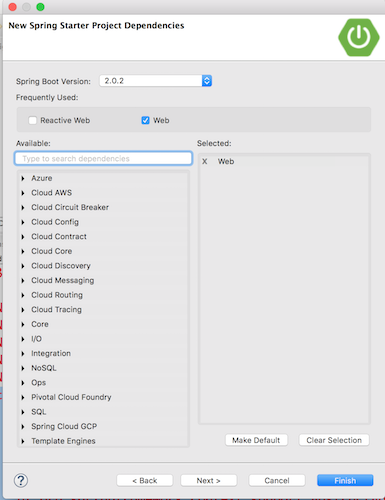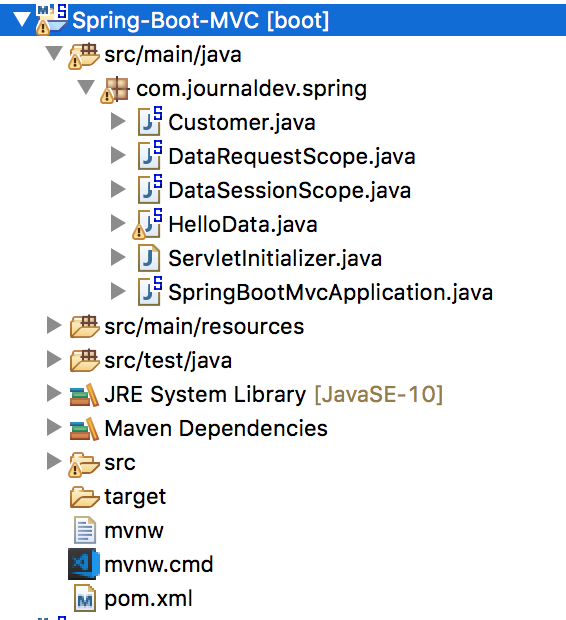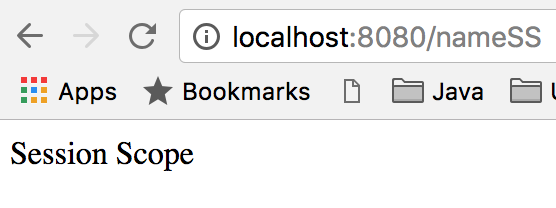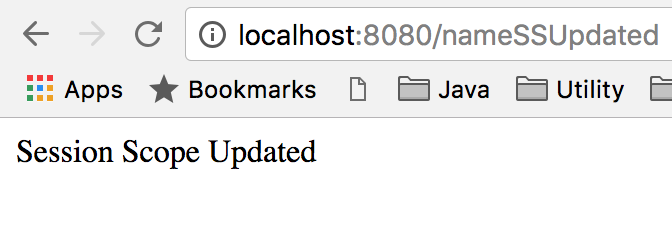Spring Bean Scopes
Spring Bean Scopes allows us to have more granular control of the bean instances creation. Sometimes we want to create bean instance as singleton but in some other cases we might want it to be created on every request or once in a session.
Types of Spring Bean Scopes
There are five types of spring bean scopes:
- singleton – only one instance of the spring bean will be created for the spring container. This is the default spring bean scope. While using this scope, make sure bean doesn’t have shared instance variables otherwise it might lead to data inconsistency issues.
- prototype – A new instance will be created every time the bean is requested from the spring container.
- request – This is same as prototype scope, however it’s meant to be used for web applications. A new instance of the bean will be created for each HTTP request.
- session – A new bean will be created for each HTTP session by the container.
- global-session – This is used to create global session beans for Portlet applications.
Spring Bean Singleton and Prototype Scope
Spring bean singleton and prototype scopes can be used in standalone spring apps. Let’s see how we can easily configure these scopes using @Scope annotation. Let’s say we have a java bean class.
package com.journaldev.spring;
public class MyBean {
public MyBean() {
System.out.println("MyBean instance created");
}
}
Let’s define the spring configuration class where we will define the method to get MyBean instance from spring container.
package com.journaldev.spring;
import org.springframework.context.annotation.Bean;
import org.springframework.context.annotation.Configuration;
import org.springframework.context.annotation.Scope;
@Configuration
public class MyConfiguration {
@Bean
@Scope(value="singleton")
public MyBean myBean() {
return new MyBean();
}
}
Note that singleton is default scope, so we can remove @Scope(value=”singleton”) from above bean definition. Now let’s create a main method and test the singleton scope.
package com.journaldev.spring;
import org.springframework.context.annotation.AnnotationConfigApplicationContext;
public class MySpringApp {
public static void main(String[] args) {
AnnotationConfigApplicationContext ctx = new AnnotationConfigApplicationContext();
ctx.register(MyConfiguration.class);
ctx.refresh();
MyBean mb1 = ctx.getBean(MyBean.class);
System.out.println(mb1.hashCode());
MyBean mb2 = ctx.getBean(MyBean.class);
System.out.println(mb2.hashCode());
ctx.close();
}
}
When the above program is executed, we will get output like below.
MyBean instance created
867988177
867988177
Notice that both MyBean instances have the same hashcode and the constructor is called once, it means that spring container is returning the same instance of MyBean always. Now let’s change the scope to prototype.
@Bean
@Scope(value="prototype")
public MyBean myBean() {
return new MyBean();
}
This time we will get the following output when the main method is executed.
MyBean instance created
867988177
MyBean instance created
443934570
It’s clear that MyBean instance is created every time it’s requested from the spring container. Now let’s change the scope to request.
@Bean
@Scope(value="request")
public MyBean myBean() {
return new MyBean();
}
In this case, we will get the following exception.
Exception in thread "main" java.lang.IllegalStateException: No Scope registered for scope name 'request'
at org.springframework.beans.factory.support.AbstractBeanFactory.doGetBean(AbstractBeanFactory.java:347)
at org.springframework.beans.factory.support.AbstractBeanFactory.getBean(AbstractBeanFactory.java:224)
at org.springframework.beans.factory.support.DefaultListableBeanFactory.resolveNamedBean(DefaultListableBeanFactory.java:1015)
at org.springframework.beans.factory.support.DefaultListableBeanFactory.getBean(DefaultListableBeanFactory.java:339)
at org.springframework.beans.factory.support.DefaultListableBeanFactory.getBean(DefaultListableBeanFactory.java:334)
at org.springframework.context.support.AbstractApplicationContext.getBean(AbstractApplicationContext.java:1107)
at com.journaldev.spring.MySpringApp.main(MySpringApp.java:12)
It’s because request, session, and global-session scopes are not available for standalone applications.
Spring Bean Request and Session Scope
For spring bean request and session scope example, we will create a Spring Boot web application. Create a spring boot starter project and choose “web” so that we can run it as a web application.

Our final project will look like the below image.
 ServletInitializer and SpringBootMvcApplication are auto-generated spring boot classes. We don’t need to make any changes there. Here is my pom.xml file, have a look at the dependencies for our application. Your pom.xml file might be slightly different based on the Eclipse version you are using.
ServletInitializer and SpringBootMvcApplication are auto-generated spring boot classes. We don’t need to make any changes there. Here is my pom.xml file, have a look at the dependencies for our application. Your pom.xml file might be slightly different based on the Eclipse version you are using.
<?xml version="1.0" encoding="UTF-8"?>
<project xmlns="https://maven.apache.org/POM/4.0.0" xmlns:xsi="https://www.w3.org/2001/XMLSchema-instance"
xsi:schemaLocation="https://maven.apache.org/POM/4.0.0 https://maven.apache.org/xsd/maven-4.0.0.xsd">
<modelVersion>4.0.0</modelVersion>
<groupId>com.journaldev.spring</groupId>
<artifactId>Spring-Boot-MVC</artifactId>
<version>0.0.1-SNAPSHOT</version>
<packaging>war</packaging>
<name>Spring-Boot-MVC</name>
<description>Spring Beans Scope MVC</description>
<parent>
<groupId>org.springframework.boot</groupId>
<artifactId>spring-boot-starter-parent</artifactId>
<version>2.0.2.RELEASE</version>
<relativePath/> <!-- lookup parent from repository -->
</parent>
<properties>
<project.build.sourceEncoding>UTF-8</project.build.sourceEncoding>
<project.reporting.outputEncoding>UTF-8</project.reporting.outputEncoding>
<java.version>10</java.version>
</properties>
<dependencies>
<dependency>
<groupId>org.springframework.boot</groupId>
<artifactId>spring-boot-starter-web</artifactId>
</dependency>
<dependency>
<groupId>org.springframework.boot</groupId>
<artifactId>spring-boot-starter-tomcat</artifactId>
<scope>provided</scope>
</dependency>
<dependency>
<groupId>org.springframework.boot</groupId>
<artifactId>spring-boot-starter-test</artifactId>
<scope>test</scope>
</dependency>
</dependencies>
<build>
<plugins>
<plugin>
<groupId>org.springframework.boot</groupId>
<artifactId>spring-boot-maven-plugin</artifactId>
</plugin>
</plugins>
</build>
</project>
Spring Bean Request Scope
Let’s create some spring components and configure them as spring beans in the spring container with scope as request and session.
package com.journaldev.spring;
import org.springframework.context.annotation.Scope;
import org.springframework.context.annotation.ScopedProxyMode;
import org.springframework.stereotype.Component;
@Component
@Scope(value = "request", proxyMode = ScopedProxyMode.TARGET_CLASS)
public class DataRequestScope {
private String name = "Request Scope";
public DataRequestScope() {
System.out.println("DataRequestScope Constructor Called");
}
public String getName() {
return name;
}
public void setName(String name) {
this.name = name;
}
}
Spring Bean Session Scope
package com.journaldev.spring;
import org.springframework.context.annotation.Scope;
import java.time.LocalDateTime;
import org.springframework.context.annotation.ScopedProxyMode;
import org.springframework.stereotype.Component;
@Component
@Scope(value = "session", proxyMode = ScopedProxyMode.TARGET_CLASS)
public class DataSessionScope {
private String name = "Session Scope";
public DataSessionScope() {
System.out.println("DataSessionScope Constructor Called at "+LocalDateTime.now());
}
public String getName() {
return name;
}
public void setName(String name) {
this.name = name;
}
}
Spring Component
Now let’s create a spring component and use spring to auto configure above beans.
package com.journaldev.spring;
import org.springframework.beans.factory.annotation.Autowired;
import org.springframework.stereotype.Component;
@Component
public class Customer {
@Autowired
private DataRequestScope dataRequestScope;
@Autowired
private DataSessionScope dataSessionScope;
public DataRequestScope getDataRequestScope() {
return dataRequestScope;
}
public void setDataRequestScope(DataRequestScope dataRequestScope) {
this.dataRequestScope = dataRequestScope;
}
public DataSessionScope getDataSessionScope() {
return dataSessionScope;
}
public void setDataSessionScope(DataSessionScope dataSessionScope) {
this.dataSessionScope = dataSessionScope;
}
}
Spring Rest Controller
Finally, let’s create a RestController class and configure some API end points for our testing purposes.
package com.journaldev.spring;
import org.springframework.beans.factory.annotation.Autowired;
import org.springframework.web.bind.annotation.RequestMapping;
import org.springframework.web.bind.annotation.RestController;
@RestController
public class HelloData {
@Autowired
private Customer customer;
@RequestMapping("/nameRS")
public String helloRS() {
return customer.getDataRequestScope().getName();
}
@RequestMapping("/nameSSUpdated")
public String helloSSUpdated() {
customer.getDataSessionScope().setName("Session Scope Updated");
return customer.getDataSessionScope().getName();
}
@RequestMapping("/nameSS")
public String helloSS() {
return customer.getDataSessionScope().getName();
}
}
Spring Boot Session Timeout Configuration
Finally, we have to configure spring boot session timeout variables, add below properties in src/main/resources/application.properties.
server.session.cookie.max-age= 1
server.session.timeout= 1
Now our spring beans with session scope will be invalidated in one minute. Just run the SpringBootMvcApplication class as spring boot application. You should see below output for our endpoints being configured.
2018-05-23 17:02:25.830 INFO 6921 --- [main] s.w.s.m.m.a.RequestMappingHandlerMapping : Mapped "{[/nameRS]}" onto public java.lang.String com.journaldev.spring.HelloData.helloRS()
2018-05-23 17:02:25.831 INFO 6921 --- [main] s.w.s.m.m.a.RequestMappingHandlerMapping : Mapped "{[/nameSSUpdated]}" onto public java.lang.String com.journaldev.spring.HelloData.helloSSUpdated()
2018-05-23 17:02:25.832 INFO 6921 --- [main] s.w.s.m.m.a.RequestMappingHandlerMapping : Mapped "{[/nameSS]}" onto public java.lang.String com.journaldev.spring.HelloData.helloSS()
Spring Bean Request Scope Test
Open any browser and go to URL https://localhost:8080/nameRS and check the console output. You should see DataRequestScope Constructor Called getting printed on each request.
Spring Bean Session Scope Test
Go to https://localhost:8080/nameSS and you would get the following output.
 Now go to https://localhost:8080/nameSSUpdated so that DataSessionScope name value is updated to Session Scope Updated.
Now go to https://localhost:8080/nameSSUpdated so that DataSessionScope name value is updated to Session Scope Updated.
 Now again go to https://localhost:8080/nameSS and you should see the updated value.
Now again go to https://localhost:8080/nameSS and you should see the updated value.
 By this time, you should see DataSessionScope Constructor Called at XXX only once in the console output. Now wait for 1 minute so that our session scoped bean is invalidated. Then again go to https://localhost:8080/nameSS and you should see the original output. Also, you should check the console message for the creation of DataSessionScope again by the container.
By this time, you should see DataSessionScope Constructor Called at XXX only once in the console output. Now wait for 1 minute so that our session scoped bean is invalidated. Then again go to https://localhost:8080/nameSS and you should see the original output. Also, you should check the console message for the creation of DataSessionScope again by the container.
 Conclusion
Conclusion
That’s all for the spring beans scope tutorial. The exploration of different scopes like singleton, prototype, request, and session helps in understanding how Spring manages bean lifecycle and dependencies. It’s important to choose the right scope for each bean to ensure efficient memory management and application performance – a Guide.


